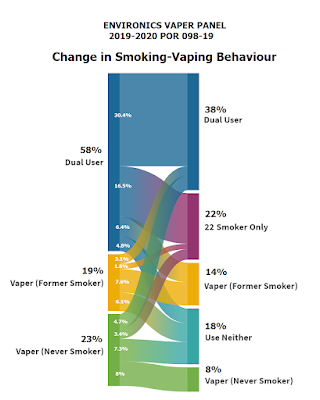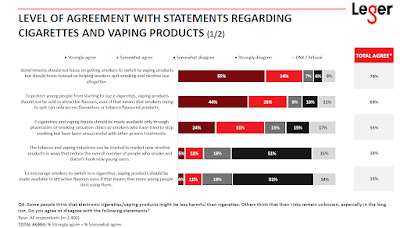Before 2021 fades completely, here is a quiz to test your knowledge of tobacco control events over the past 12 months. The answers can be found at the bottom of this post. No peeking!
1. In 2021, one of Canada's major pension funds announced that it would divest its tobacco shares. Which one was it?
2. In 2021, which two provinces banned all flavours in vaping liquids other than tobacco flavour?
3. In 2021, Health Canada reported that over the past year it had inspected more than 300 Instagram accounts managed by vaping manufacturers or retailers. How many were found NOT to be following the law? (Bonus points -- for what percentage of infractions were charges laid?)
4. In 2021, in which province did smokers face a $10 per carton increase in tobacco taxes?
5. In 2021, which vaping product made by a multinational tobacco company was removed from the Canadian market (and which one was introduced)?
6. In 2021, tobacco companies' insolvency protection entered its third year, and the companies were authorized to continue "business as usual" while they tried to reach a settlement with the provinces to resolve the lawsuits against them. Which province stated that its objective was to end "business as usual" for tobacco companies in Canada?
7. In 2021, the Quebec Court of Appeal ruled on a constitutional challenge to that province's Tobacco Control Act filed by the Canadian and Quebec Vaping Associations. On how many issues did the Court side with the vape store owners?
8. In 2021, Statistics Canada released the second cycle of the Canadian Tobacco and Nicotine Survey. Among Canadians who reported using a vaping device over the past month, what proportion said they were former smokers?
9. For the fiscal year ending March 31, 2021 - and to the nearest $ billion, how much revenues did Canadian governments report they had received in tobacco taxes?
10. In December 2021, New Zealand announced its strategy to achieve Smokefree Aotearoa by 2025. Which of the following were not included in its strategy:
a) Ensuring Indigenous leadership and decision-making across all levels of the action plan.
b) Increasing stop smoking services
c) Lowering the amount of nicotine in tobacco products
d) Examine how best to restrict filters
e) Forbidding tobacco sales or supply to people born 2007.
f) Suing tobacco companies
11. Match the slogan to the company
A) Philip Morris International
B) British American Tobacco
C) Altia
1. "Moving beyond smoking"
2. "A better tomorrow"
3. "Delivering a Smoke-Free Future"
12. In 2021, Canadian tobacco companies filed financial reports with the Ontario court as part of their efforts to maintain insolvency protection while they negotiate a settlement with provincial governments and other Canadians who are suing them. From these reports, what proportion of their expenses are related to purchasing tobacco leaf (to the nearest 10%)?
13: What is their profit margin (retained earnings as a percentage of total revenues, excluding tobacco taxes) to the nearest 10%?
14. The Canadian Student Tobacco Alcohol and Drug Survey (CSTADS) measured tobacco and e-cigarette use among high school students in 2008-2009, 2010-2011, 2012-2013, 2014-2015, 2016-2017 and 2018-2019. In 2018-19, 19% of students in grades 7 to 12 (approximately 402,000 young Canadians) had ever tried smoking a cigarette, and 34% had ever tried an e-cigarette. What change was seen in these behaviours in the 2020-2021 cycle of the biennial survey?
15. In answer to Health Canada's 2021 Canadian Cannabis Survey, which of the following substances did the fewest Canadians think were associated with moderate or great risk to the user?
A. Drinking alcohol on a regular basis
B. Smoking tobacco on a regular basis
C. Using an e-cigarette with nicotine on a regular basis
D. Smoking cannabis on a regular basis
E. Vaporizing cannabis on a regular basis
F. Eating cannabis on a regular basis.
16. Which of the following Canadian-based companies and products were in development in 2021
A. PODA. A heated-nicotine product that saturates tea pellets with synthetic nicotine (and is therefore not subject to current federal laws).
B. TAAT. A nicotine-free hemp cigarette that is engineered to mimic a tobacco cigarette (but without the nicotine).
C. TPJ. The former "Punk Juice" company is expanding to make 36 million non-tobacco nicotine pouches per month.
D. DITCH. A programmable e-cigarette designed to wean smokers off nicotine.
17. Which Canadian legislature set new precedents by adopting a law to ban smoking in all publicly-funded rental housing as well as banning price-promotions aimed at tobacco retailers?
18. What tobacco-related commitments were included in the platforms of federal political parties during the election for Canada's 44th Parliament?
19. During the 2021 federal election, which vaping organization registered with Elections Canada as a third party, and who was their financial agent?
20. As of December 11, 21 months have passed since the World Health Organization declared COVID-19 to be a pandemic. How long is it since the WHO identified smoking as a pandemic?
21. In 2021, did COVID surpass tobacco as the leading cause of preventable death in Canada?
------------------------------------------------------------------------------------
Answers
1. Quebec's Caisse de dépot announced in January that it had signed the Tobacco-Free Finance Pledge . The "Caisse" was established by the Quebec government to manage several public and parapublic pension plans in Quebec, including the Quebec Pension Plan. Other large public pension funds in Canada which do not invest in tobacco include Ontario's Teachers Pension Plan, OMERS, and Alberta's AIMCo. The Canadian Pension Plan Investment Board has not adopted this responsible investment policy.
2. These flavour restrictions came into force in Prince Edward Island in March, and in New Brunswick in September.
3. Health Canada found non-compliance on 53% of the accounts. No charges were laid, although warning letters were sent.
4. Cigarette taxes went up by $10 per carton in British Columbia: $4 as a result of federal tax increases and $6 following a provincial tax increase. Tobacco taxes are now highest in B.C., although sales tax differences make the total price higher in some Atlantic provinces.
5. In August 2021, Japan Tobacco International withdrew its Logic Compact device from the Canadian Market. In September 2021, Philip Morris International began selling VEEV vaping products in Ontario.
6. In 2021, none of the provinces made any public comments about the lawsuits. To date, none has identified any non-monetary objectives.
7. Zero. The Appeal Court upheld the Quebec law in its entirety.
8. One-third (33%). Of the estimated 1.46 million Canadians who had used a vaping device in the past month, 485,100 were former smokers, 438,500 were never smokers and 532,400 were current smokers (smoked cigarettes in the past month).
9. $7.53 billion. Of that amount, $4.46 billion was received by provincial governments, $54 million by territorial governments and $3.1 billion by the federal government.
10. The only measure not included in New Zealand's plan is suing tobacco companies.
11. Their recently-trademarked slogans reflect their transformation goals: PMI is "delivering a Smoke-Free Future", BAT has "A Better Tomorrow", Altria is "Moving beyond smoking."
12: Two of the companies provided information on how much they spent on tobacco - 4% and 2% of their operating costs respectively.
13: The profit margin exceeded 50%. During the period reported, the annual combined net (after tax) cash retained by the companies is about $1.7 billion dollars. This is about one-half of the $3.3 billion they collectively received through sales and other activities (after excise, sales and income taxes are discounted).
14. The formerly biennial CSTADS survey did not take place in 2020-2021. The contract for the next cycle was not signed until December 2020, with work commissioned for the 2021-2022 school year.
15. F. The 2021 Canadian Cannabis Survey found that the percentage of Canadians who thought people have moderate or great risk of harming themselves with regular use was as follows:
A. Drinking alcohol on a regular basis - 75%
B. Smoking tobacco on a regular basis - 95%
C. Using an e-cigarette with nicotine on a regular basis - 89%
D. Smoking cannabis on a regular basis - 74%
E. Vaporizing cannabis on a regular basis - 75%
F. Eating cannabis on a regular basis - 63%
16. They all are.
- PODA is based in Vancouver.
- TAAT is based in Vancouver
- TJP is based in Pickering
- DitchLabs is based in Montreal
17. Nunavut adopted a new Tobacco and Smoking Act in spring 2021. The law has not yet come into force.
18. The platform commitments were as follows:
- Liberal Party platform said it would "Move forward with a national tax on vaping products and require tobacco manufacturers to pay for the cost of federal public health investments in tobacco control"
- The Conservative Party's main platform was silent about tobacco, but its costed strategy included a cost recovery fee on tobacco companies.
- The NDP's main platform was silent about tobacco, but its costed plan included a cost recovery fee on tobacco companies, as well as a vaping tax.
- The Green Party platform was silent about tobacco, although its commitment to expand the list of single-use plastics that it would ban could be read as a reaffirmation of its 2019 position in favour of banning cigarette filters.
- The Bloc Québécois main platform was silent about tobacco.
19. Rights4Vapers registered with Elections Canada as an official third party, and the chairman of the Vaping Industry Trade Association was listed as their financial agent.
20. More than 35 years. In its 1986 resolution (WHA39.14), the World Health Organization called for action on the "pandemic of smoking and other forms of tobacco use, which results in the loss of the lives of at least one million human beings every year and in illness and suffering for many more."
21. No. Between January 1, 2021 and December 25, 2021 there were 14,400 confirmed COVID deaths. (Other estimates of excess deaths from COVID in 2021 are not yet available, although they are for 2020). Annual deaths from smoking in Canada are currently estimated at 51,700.




























